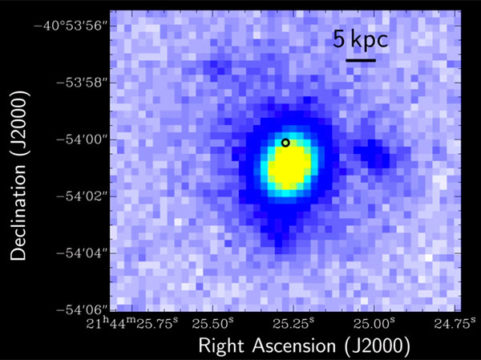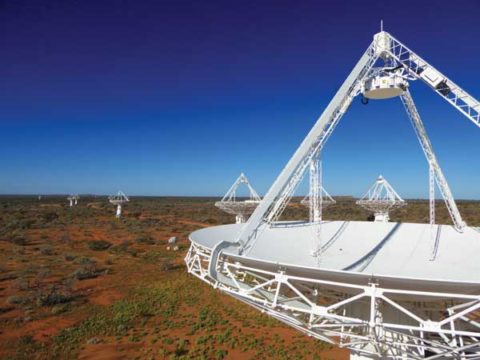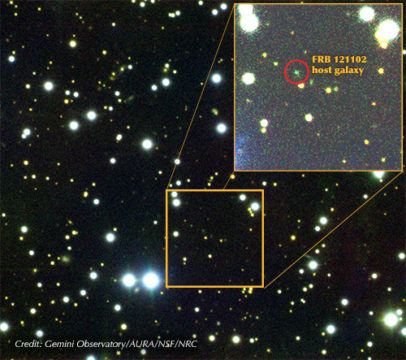A next-gen Australian radio array has enabled astronomers to home in on the source of a mysterious fast radio burst — and the source is not what they expected.

CSIRO / Sam Moorfield
If you could “listen” to the whole radio sky at once, you’d mostly hear a faint background hiss, like the static between radio stations. But roughly every 10 seconds, you’d pick up a downslurred whistle reminiscent of the Northern Cardinal’s song. This bright sound comes from so-called fast radio bursts (FRBs). Each one lasts only a small fraction of a second (hence “fast”), but in that time it carries some 10,000 times the energy of the Sun.
Since their discovery in 2007, FRBs have maintained an air of mystery. Astronomers have spotted 76 of the fleet emissions so far (and counting), but theories about their origins abound in part because they’re difficult to pin down. Until now, astronomers have only been able to localize one emission, FRB 121102, and that was only because it repeated often enough that astronomers could home in on its origin.
Now, Keith Bannister (CSIRO) and colleagues have used the 36-dish Australian Square Kilometer Array Pathfinder (ASKAP) to pinpoint the source of another FRB — one that doesn’t repeat. The feat, published on June 27th in Science, offers another avenue to understanding these puzzling sources.
One of These Is Not Like the Other

CSIRO
When ASKAP captured the signal known as FRB 180924, an automated search pipeline triggered the receivers to save everything about the event. That information enabled ASKAP to not only detect the event, it also recorded enough information to pinpoint its source to within 0.12 arcsecond, in a massive galaxy whose light has traveled for 3.6 billion years to reach Earth.
Bannister’s team followed up with sensitive observations of the galaxy and its surroundings using the Very Large Telescope and the Gemini South Telescope in Chile and the Keck II Telescope in Hawai‘i. Images show the galaxy is a cross between an elliptical and a spiral. If it has any spiral arms around its big bulge, they’re tightly wound and difficult to see. Spectroscopic measurements show little to no evidence of star formation. If the burst really belongs to this galaxy, it’s in its anemic outer reaches.
This finding is in stark contrast to the home of the repeating burst FRB 121102. It appears to originate from a dwarf galaxy, from within a region that’s birthing stars at a high rate. Given the plethora of new stars, astronomers think FRB 121102 is likely a highly magnetized kind of newborn neutron star known as a magnetar.

Gemini Observatory / AURA / NSF / NRC
FRBs are known for having large dispersion measures, which means that the lower frequencies arrive much later than the higher-frequency ones. That’s what gives them the “sound” of a cardinal-like downslurred whistle. The longer-frequency photons are delayed by interacting with electrons, and in the case of FRB 121102, the whistle was so extended, it indicated that not only had the pulse traveled a long way, but that the source itself was probably embedded in highly magnetized plasma, which supports the magnetar scenario.
But are all FRBs magnetars? Astronomers have already been saying that even if the scenario pans out for FRB 121102, it might not explain FRBs as a population. The vast majority of these events, after all, don’t repeat.
“Basing models entirely on [FRB 121102’s] properties is dangerous, since the FRB population could be made up of different classes of sources,” says Victoria Kaspi (McGill University, Canada). Indeed, Bannister and colleagues’ localization of FRB 180924 in a galaxy that has retired from star formation suggests that this source has nothing to do with newborn stars, magnetars or otherwise.
“We now know that some FRBs originate from environments very different from that of FRB 121102,” says Kaspi, who was not involved in the study. “That is a very important finding!”
CSIRO / Sam Moorfield
There’s another aspect of FRB 180924 that’s also telling: its dispersion measure. The distance to the source’s galaxy completely explains the dispersion measure so, unlike the repeater, this source doesn’t seem to be embedded in a highly magnetic plasma.
“If they are all like 121102 then yes, we'd expect the source itself to contribute [to the dispersion measure],” Kaspi notes. “But clearly, they are not all like FRB 121102!”
This single burst is likely the first of many that ASKAP will pinpoint, and other telescopes are working on that ability, too. The Canadian Hydrogen Intensity Mapping Experiment (CHIME) array, for example, could localize sources if it had outrigger telescopes, like “mini-CHIMES,” to provide additional information. That would be a boon for an instrument that’s already finding FRBs by the dozen. “Indeed we are planning CHIME outrigger telescopes right now,” Kaspi says.
For now, FRBs retain their mystery, but it’s only a matter of time before we unveil what unique physics is producing these events.
Learn more about fast radio bursts — and ASKAP’s role in catching them — in this video:
 0
0









Comments
You must be logged in to post a comment.